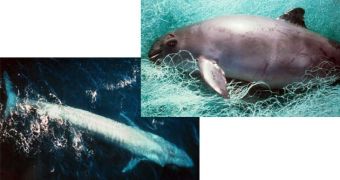One of the most difficult aspects of whale research is explaining their widely-varying sizes. The vaquita porpoise, which weighs barely 55 kilograms, cannot be readily placed in the same category as the blue whales. The latter is the largest animal in existence, weighing around 180 metric tons. Still, they are both cetaceans, and scientists have been struggling to find an explanation for how these creatures have evolved to show this extensive size range, which exceeds any other found in nature. According to a new scientific study, it would appear that food sources play an important role in this.
Numerous scientists have in the past proposed various hypotheses to explain these differences. Ideas ranged from sea level variations to changes in behavior, but none of them managed to explain the phenomenon in a satisfying manner. Scientists behind the new study say that the root cause is much more ancient, proposing that whales, dolphins, and porpoises actually draw their respective sizes from very old dietary preferences, to which they stuck for millions of years of evolution. Given that cetaceans first developed more than 55 million years ago, not 10 million ears after the dinosaurs went extinct, the idea may not be as far-fetched as first apparent.
According to the fossil record, the first whales were very similar to crocodiles and seals. They did not live long, and disappeared about 35 million years ago, during a mysteries die-off event that has yet to be fully explained. Unlike the archaic cetaceans, the ones that appeared afterwards, much more similar to modern ones in appearance, diversified into numerous shapes and sizes, which eventually led to the huge diversity we have today. Rather than using genetics or the fossil record for the new investigation, researchers turned to body size for information.
The work was conducted by University of California in Los Angeles (UCLA) evolutionary biologist Graham Slater, who collaborated closely with colleague Samantha Price, who is also an evolutionary biologist, but at the University of California in Davis (UCD). The group looked at animal length data collected in previous studies, and covering the females of more than 80 whale species living today. The animals were then separated into three dietary groups – filter feeders, cephalopod specialists, and generalist fish eaters. The study hints that filter feeders, including the blue whale, are the largest because of the abundance of food.
Cephalopod specialists are also large because they need to dive to great depths to catch squids and other marine creatures. Generalist fish eaters, such as bottlenose dolphins, actually dropped in size over more recent times, but no one knows why. This research is “first real test of the idea that the evolution of large body size in cetaceans is a dietary adaptation,” says George Mason University paleontologist Mark Uhen, quoted by ScienceNow.

 14 DAY TRIAL //
14 DAY TRIAL //